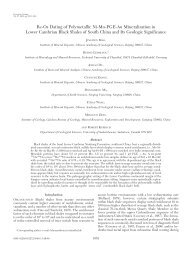Uranium Ore Deposits
Uranium Ore Deposits
Uranium Ore Deposits
Create successful ePaper yourself
Turn your PDF publications into a flip-book with our unique Google optimized e-Paper software.
EDUCATION<br />
Resource perspective<br />
The resource distribution of uranium in the Earth‘s<br />
crust is of more than passing interest, because nuclear<br />
reactors may become the preferred source of electricity<br />
generation in the future, once climate change and oil/gas<br />
shortages are widely perceived as particularly unpleasant.<br />
Figure 13 gives an overview on the availability of uranium<br />
in the Earth‘s lithosphere and hydrosphere. The amount of<br />
uranium in the several types of uranium deposits increases<br />
progressively as the grade decreases. The data in<br />
Figure 13 show that at the present rate of mining the<br />
amount of uranium in ore with more than 0.1 % U will last<br />
more than 1000 years. Much of this amount is uneconomic<br />
at the current price. The uranium resouces recoverable<br />
at a price of up to 130 USD/kg U are estimated at 5.5 Mt<br />
(NEA 2008).<br />
Average seawater has an abundance of 3.2 ppb (ng/g)<br />
U, and there are about 4.5 Gt U in the form of uranyl-tricarbonate<br />
[UO 2<br />
(CO 3<br />
) 3<br />
4-<br />
] in the oceans which have a total mass<br />
of seawater of 1.4 x 1018 t. <strong>Uranium</strong> extraction by adsorption<br />
has been experimentally tested, and seawater mining<br />
could be done powered by ocean currents. Industrial-scale<br />
production was, however, never tested and is estimated<br />
to become profitable at a price of about 400-1200 USD/kg U<br />
(Macfarlane & Miller 2007).<br />
Economic perspective<br />
The production cost of electric energy from nuclear<br />
power plants in 2005 was 1.7 US ct/kWh, compared to<br />
2.2 US ct for coal, 7.5 ct for natural gas, and 8.1 ct for oil<br />
(operation, fuel and maintenance; US data in NEA 2008).<br />
Given that the cost of natural uranium constitutes only<br />
3 - 5 % of the cost of a kilowatt-hour of nuclear-generated<br />
electricity, compared to 78 % for coal, 94 % for natural gas<br />
and 91 % for oil, large increases in the price of natural<br />
uranium have much less impact than price hikes for coal,<br />
gas or oil. Therefore, nuclear-generated electricity will be<br />
more and more competitive with other electricity sources,<br />
in spite of the high initial investment cost.<br />
A simple back-of-the-envelope calculation can estimate<br />
the influence of price fluctuations of raw materials<br />
for various energy sources: The relationship between the<br />
energy output from equal amounts of natural uranium and<br />
steam coal is about 10,000, and the relationship between<br />
the present-day price of equal amounts of natural uranium<br />
(150 USD/kg U) and steam coal (150 USD/t coal) is 1000.<br />
Therefore, an increase in the current price of uranium by a<br />
factor of 2 (when very-low-grade uranium enriched rocks<br />
become mineable, and also seawater mining may be feasible)<br />
would have only 10 % of the impact on electricity price<br />
compared to the same amount of price increase for steam<br />
coal. The same calculation is, of course, much in favor of<br />
solar energy for which solar radiation comes free, but the<br />
price of large-scale conversion into electricity is currently<br />
still prohibitive.<br />
There is an enormous potential of cheap electric energy<br />
from nuclear power, limited not by natural resources, but<br />
by political and environmental issues. A particularly intriguing<br />
perspective is added by new breeder technology<br />
which could provide all energy requirements on Earth in a<br />
sustainable manner (i.e. no depletion), as already pointed<br />
out by Cohen in 1983.<br />
Literature<br />
1.<br />
2.<br />
3.<br />
4.<br />
5.<br />
6.<br />
7.<br />
Cohen BL (1983): Breeder reactors: a renewable energy source.<br />
American Journal of Physics 51: 75-76<br />
Deffeyes KS, MacGregor ID (1980) World uranium resources.<br />
Scientific American 242: 66-76<br />
Jaireth S, McKay A, Lambert I (2008): Association of large sandstone<br />
uranium deposits with hydrocarbons. http://www.ga.gov.au/<br />
image_cache/GA11094.pdf<br />
Jefferson CW, Thomas DJ, Gandhi SS, Ramaekers P, Delaney G,<br />
Brisbin D, Cutts C, Quirt D, Portella P, Olson RA (2007): Unconformity-associated<br />
uranium deposits of the Athabasca Basin,<br />
Saskatchewan and Alberta. In: Mineral deposits of Canada: a<br />
synthesis of major deposit-types, district metallogeny, the evolution<br />
of geological provinces, and exploration methods (Goodfellow<br />
WD, ed), 273-305. Geological Association of Canada, Special<br />
Publication 5.<br />
Macfarlane AM, Miller M (2007): Nuclear Energy and uranium<br />
resources. Elements 3: 185-192<br />
Meshik AP, Hohenberg CM, Pravdivtseva OV (2004): Record of<br />
cycling operation of the natural nuclear<br />
reactor in the Oklo/Okelobondo area in Gabon. Physical Review<br />
Letters 93 (18): Paper 182302, 4 p.<br />
NEA (2008) <strong>Uranium</strong> 2007: Resources, production and demand.<br />
A joint report by the OECD Nuclear Energy Agency and the International<br />
Atomic Energy Agency. OECD, Paris.<br />
Dr. Bernd Lehmann studied geology at the<br />
University of Heidelberg and the Free University<br />
of Berlin (PhD on tin deposits in Bolivia<br />
in 1979), and then was a postdoc at the<br />
Harvard University followed by several years<br />
as an exploration geologist in Central Africa<br />
and SE Asia. Since 1991, he has the Chair of<br />
Economic Geology at Technical University<br />
of Clausthal and studies all kinds of mineral<br />
deposits with a focus on South America.<br />
bernd.lehmann@tu-clausthal.de | www.tu-clausthal.de/~mrbl<br />
Issue 02 | 2008<br />
www.advanced-mining.com<br />
26










